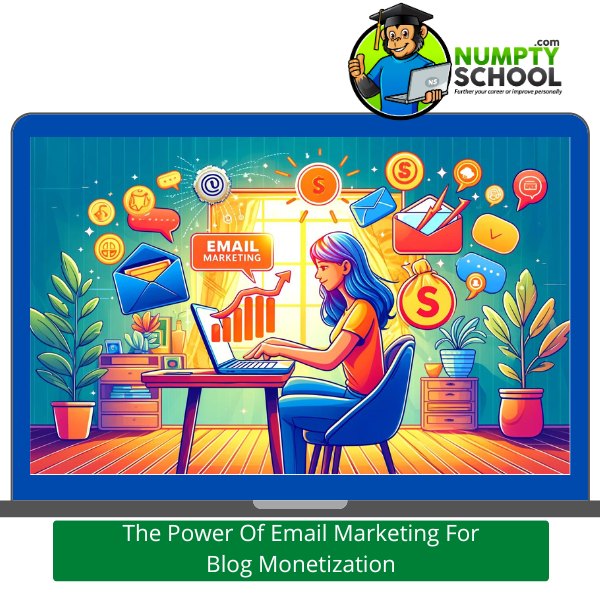The Power Of Email Marketing For Blog Monetization

Email marketing has long been hailed as one of the most effective tools in a blogger’s arsenal for monetization. With its unparalleled ability to engage audiences directly, email marketing offers bloggers a unique opportunity to nurture relationships with their readers, drive traffic to their blogs, and ultimately, generate revenue. In this comprehensive guide, we’ll delve deep into the world of email marketing and explore how bloggers can harness its power to monetize their blogs effectively.
Introduction to Email Marketing
Email marketing is a digital marketing strategy that involves sending emails to a targeted list of subscribers with the aim of promoting products, services, or content. For bloggers, email marketing serves as a direct line of communication with their audience, allowing them to deliver valuable content, updates, and offers straight to their subscribers’ inboxes. Unlike social media or other forms of digital marketing, email marketing offers unparalleled reach and engagement, making it an indispensable tool for blog monetization.
Building an Email List
One of the first steps in leveraging the power of email marketing for blog monetization is building a quality email list. While it may be tempting to focus on growing your list as quickly as possible, quality should always take precedence over quantity. Instead of simply collecting email addresses, focus on attracting subscribers who are genuinely interested in your blog and its content. Offer incentives such as lead magnets or exclusive content to encourage visitors to sign up for your email list.
Creating Compelling Content
Once you’ve built a solid email list, the next step is to create compelling content that will engage your subscribers and keep them coming back for more. Crafting engaging emails requires more than just promotional content; it requires storytelling. Use your emails to tell stories that resonate with your audience, evoke emotion, and ultimately, compel them to take action. Whether you’re sharing personal anecdotes, success stories, or valuable insights, make sure your content adds value and keeps your subscribers hooked.
Segmentation and Personalization
Segmentation and personalization are key components of a successful email marketing strategy. By segmenting your email list based on factors such as demographics, interests, and purchase history, you can tailor your content to better meet the needs and preferences of your subscribers. Personalizing your emails with the recipient’s name, location, or past interactions can also help increase engagement and drive conversions. Remember, the more relevant your emails are to your subscribers, the more likely they are to open, read, and act on them.
Promoting Products and Services
One of the primary ways bloggers monetize their blogs through email marketing is by promoting products and services to their subscribers. Whether you’re an affiliate marketer, a creator selling digital products, or a blogger with your own line of merchandise, email marketing offers a direct channel for promoting your offerings to your audience. However, it’s important to strike a balance between promotional content and value-added content to maintain trust and credibility with your subscribers.
Driving Traffic to Your Blog
In addition to promoting products and services, email marketing can also be used to drive traffic to your blog. By sharing blog posts, articles, and other content via email, you can encourage subscribers to visit your blog, engage with your content, and ultimately, become loyal readers. Incorporating links to your blog within your emails and teasing upcoming content can help pique your subscribers’ curiosity and entice them to click through to your blog.
Email Automation
Email automation is another powerful feature of email marketing that bloggers can leverage to streamline their workflows and deliver timely, relevant content to their subscribers. By setting up automated email sequences, you can welcome new subscribers, nurture leads, and re-engage inactive subscribers without having to manually send each email. From welcome emails to abandoned cart reminders, email automation allows you to stay connected with your audience 24/7, even when you’re not actively working on your blog.
Measuring Success
As with any marketing strategy, it’s essential to track and measure the success of your email marketing efforts. Key metrics to monitor include open rates, click-through rates, conversion rates, and unsubscribe rates. By analyzing these metrics, you can gain insights into what’s working and what’s not, allowing you to refine your strategies and optimize your campaigns for better results. Experiment with different subject lines, email formats, and calls to action to see what resonates most with your audience.
Building Relationships
At its core, email marketing is about building and nurturing relationships with your subscribers. Instead of treating your email list as a mere marketing tool, think of it as a community of like-minded individuals who share a common interest in your blog and its content. Take the time to engage with your subscribers, respond to their emails, and address their questions and concerns. By fostering meaningful relationships with your audience, you can turn casual readers into loyal fans and advocates for your blog.
Avoiding Common Mistakes
While email marketing can be incredibly effective, it’s not without its pitfalls. Common mistakes to avoid include sending too many emails, neglecting to segment your list, and bombarding subscribers with overly promotional content. Additionally, failing to comply with legal and ethical considerations such as GDPR and CAN-SPAM regulations can land you in hot water and damage your reputation. Learn from these mistakes and strive to deliver value to your subscribers while respecting their privacy and preferences.
Legal and Ethical Considerations
When engaging in email marketing, it’s crucial to adhere to legal and ethical standards to protect both your subscribers and your reputation. This includes obtaining explicit consent from subscribers before adding them to your email list, providing clear opt-out mechanisms, and honoring unsubscribe requests promptly. Failure to comply with regulations such as GDPR and CAN-SPAM can result in hefty fines and tarnish your brand’s image, so it’s essential to stay informed and follow best practices.
Staying Relevant in a Crowded Inbox
In today’s digital age, the average person’s inbox is inundated with promotional emails vying for their attention. To stand out amidst the competition, it’s essential to deliver value and relevance with every email you send. Experiment with personalized subject lines, eye-catching visuals, and interactive content to capture your subscribers’ attention and entice them to open and engage with your emails. By delivering content that resonates with your audience’s interests and needs, you can cut through the noise and stay top-of-mind with your subscribers.
Future Trends in Email Marketing
As technology continues to evolve, so too does the landscape of email marketing. Looking ahead, we can expect to see continued innovation in areas such as AI-powered personalization, interactive email experiences, and advanced automation capabilities. By staying abreast of these emerging trends and experimenting with new technologies and strategies, bloggers can stay ahead of the curve and maintain a competitive edge in their email marketing efforts.
Case Studies
To illustrate the power of email marketing for blog monetization, let’s take a look at a few real-world case studies:
- The Skimm: A daily newsletter that delivers bite-sized news updates and lifestyle content to subscribers’ inboxes. Through strategic partnerships and sponsored content, The Skimm has successfully monetized its email newsletter while maintaining a loyal subscriber base.
- Neil Patel: A renowned digital marketer and blogger who uses email marketing to promote his online courses, consulting services, and affiliate products. By providing valuable content and insights to his subscribers, Neil Patel has built a thriving business empire fueled by email marketing.
Conclusion
In conclusion, email marketing is a powerful tool for blog monetization that offers bloggers a direct line of communication with their audience, unparalleled reach and engagement, and the ability to drive traffic, promote products, and build relationships. By following best practices, staying informed about legal and ethical considerations, and experimenting with new technologies and strategies, bloggers can leverage the power of email marketing to monetize their blogs effectively and achieve their business goals.
FAQs
Is email marketing still relevant in the age of social media?
Yes, email marketing remains one of the most effective digital marketing channels for bloggers and businesses alike. Unlike social media platforms, which are subject to algorithm changes and organic reach limitations, email marketing offers direct access to your audience’s inbox and higher engagement rates.
How often should I email my subscribers?
The frequency of your emails will depend on your audience and the type of content you’re delivering. While some bloggers may send daily newsletters, others may opt for a weekly or monthly cadence. The key is to find a balance that keeps your subscribers engaged without overwhelming them with too many emails.
How can I grow my email list organically?
There are several strategies you can employ to grow your email list organically, including creating compelling lead magnets, optimizing your website for email sign-ups, leveraging social media and content marketing, and collaborating with other bloggers and influencers in your niche.
What metrics should I track to measure the success of my email marketing campaigns?
Key metrics to track include open rates, click-through rates, conversion rates, unsubscribe rates, and email deliverability rates. By monitoring these metrics, you can gain insights into the effectiveness of your campaigns and make data-driven decisions to optimize your strategies for better results.
How can I keep my email content fresh and engaging?
To keep your email content fresh and engaging, try incorporating a variety of content types, such as articles, videos, podcasts, and interactive elements. Experiment with different subject lines, email formats, and personalization techniques to capture your subscribers’ attention and encourage interaction with your emails.



